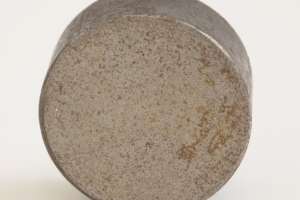
High carbon steels, as their name suggests, are steels with high carbon content. If iron is heated to a high temperature, it dissolves carbon, which would normally precipitate upon cooling. However, if this liquid metal is cooled very quickly by ‘quenching’ it in water, the carbon is trapped and distorts the structure of the substance, forming high carbon steel. If you continue increasing the carbon content of steel beyond about 2%, it eventually becomes cast iron, the material famously used in Le Creuset cookware, a much harder, denser and more brittle metal as a result of its impurities.
The carbon in this sample of steel strengthens it and gives it the ability to harden by heat treatment. It also makes it less ductile and weldable than ordinary steel, and it becomes much more brittle as a result of its impurities. Because of its extreme hardness and resistance to wear, high carbon steel is often used for things like cutting tools that retain their sharp edge, and masonry nails that can be driven into concrete blocks or bricks without bending (although due to their brittleness they do have a propensity to fracture if they are mistreated).
As you can see from the flecks of rust on the surface of this sample and its blackened sides, unlike stainless steel, this metal is not resistant to oxidation. However, the carbon content of this sample does mean it corrodes much more slowly than low carbon steel or iron.
Sample ID: 48
Add materials you find interesting to your own selections.
Use the  button to select a material and get started.
button to select a material and get started.



